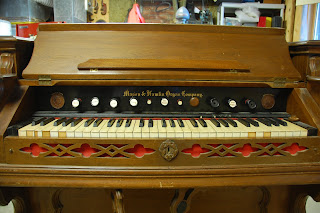Restoring a Reed Organ - Part 4: An Overview of the Instrument
As mentioned in a previous post, when the organ was at Jan and Bill's place, I only had my old Blackberry with me and the picture quality was not great. Now that we have the organ in Dad's workshop, we decided to take some photos with his Nikon camera. Now, one thing you should know is that photography is not amongst the Churchman's greatest gifts. At any rate, the should give you an idea of what the organ looks like and some of its interesting, and quite lovely features.
Here is a view of the keyboard with the keyboard cover opened. It is quite a nice presentation.




Here is a view of the keyboard with the keyboard cover opened. It is quite a nice presentation.
Here are a few close up shots. You will note that the instrument is a C-C instrument with 61 keys. Many keyboards are F-F. The front of a few of the keys are missing and all the white keys are quite yelloed and dirty. The black keys are in quite good shape, though. No splits or breaks on them. A few are a bit scratched, but generally look quite good.
Here are the stop faces on the bass side and then the treble side. You can see that a few are missing and a few of the faces have fallen off and are lost. A couple are loose and have been placed back on and I am not sure if they are in the right place or not. The treble stop next to the Vox Humana is missing and has a "plug" in that hole. The Vox Human stop is stationary and is worked by two smaller on/off pistons on either side.

Here's a close up of each of the medallions:
A closer look at the Mason & Hamlin
& Mason & Risch & Newcombe stencils
Now, moving to the lower half of the organ, we can see the two knee levers.
The grand organ is on the bass side and the swell is on the treble side.
One of the two inserts is in place.

The carpet on the pedals is badly worn. I'm not too worried since it looks like it came straight from Grandma's living room anyway.

And now, a bit of a look as some of the lovely features of the case.
Here is a view of the side carvings and candle stands:
On the front "legs" (they're not really legs but I'm not sure what to call them) on each side is this little geometric, sheild-like ornamentation, which is quite a contrast with the more florid side carvings, I think.
The cover lock is also quite ornate... anyone have a key that would fit this?
Let's take a look at the back:
It's a bit rough looking, with a very different finish? Is it a different wood, or has the front and top been previously refinished? You can see an oppening for the sub-bass reeds about half-way down. It had a cover (sitting on top of the organ) that was split down the centre and needs repairing. Some close ups of that opening, below, with a view of the sub-bass reeds.

Opening the top of the case, we see that there is some significan damage around the hinges. In fact, the original rectangular hinges are gone and replaced with something you might use on your backyard gate. You can see the indentation and screw holes from the original hinge. It is much the same with the hinge on the other end.
Looking inside you can see some damage to the finish where water or something has been spilled (we found evidence of this all down the interior, and into the action, keys and even bellows - as we shall see in a future post).
A number is visible on the interior of the case:
Not enough digits for a serial number... probably the case number.
On the interior of the side of the case (bass side) is this cabinet patent label. This does not give us a precise date for the organ, but it establishes it is post-1870, but we already knew that as one of the medallions is an 1873 medallion.
A Look at the Vox Human vane. It is dusty and quite brittle. Cracked and torn in a couple of places.
A closer look at the vane - It appears to be original.
From another angle; catching a view of the sub-bass box (still have to learn all the technical terms), and a bit of the stop action. It is looking sideways from the treble side to the bass side.
This is the back of the stop board. All the stop mechanism seem to function, although several are disconnected from the stop knobs.
Someone has conveniently numbered them all and they appear to be in the right order. "7" is completely disconnected with the cloth washer missing, but "8" is in working order, but needing a thorough cleaning!
A view inside of the front treble corner. I should say we have found no evidence of mice so far, but lots of evidence of spiders and other little bugs. The red cloth is the back of the grill . I'm not sure if it is original or not. It is not a very nice material and quite faded.
Another number, this one on the top of the action board.
Here we are back outside again. The base is a bit loose and will require some fixing.
Next time: Let's get the back off this thing and take a look at the bellows!






























Comments